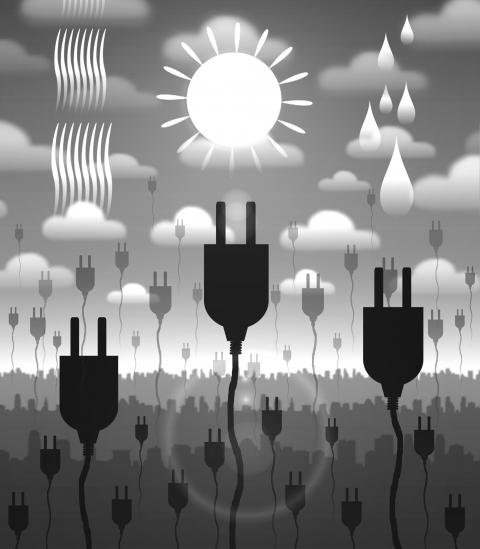The solution to human-induced climate change is finally in clear view. Thanks to rapid advances in zero-carbon energy technologies and sustainable food systems, the world can realistically end greenhouse gas emissions by mid-century at little or no incremental cost, and with decisive benefits for safety and health.
The main obstacle is inertia: Politicians continue to favor the fossil-fuel industry and traditional agriculture mainly because they do not know better or are on the take.
Most global warming, and a huge burden of air pollution, results from burning fossil fuels: coal, oil and gas. The other main source of environmental destruction is agriculture, including deforestation, excessive fertilizer use and methane emissions from livestock.

Illustration: Yusha
The energy system should shift from heavily polluting fossil fuels to clean, zero-carbon energy sources such as wind and solar power, and the food system should shift from feed grains and livestock to healthier and more nutritious products.
This combined energy-and-food transformation would cause net greenhouse gas emissions to fall to zero by mid-century and then move into the negative, as atmospheric carbon dioxide is absorbed by forests and soils.
Reaching net-zero emissions by mid-century, followed by negative emissions, would likely secure the goal of limiting global warming to 1.5°C relative to Earth’s preindustrial temperature.
Alarmingly, warming has already reached 1.1°C and the global temperature is rising about 0.2°C each decade. That is why the world must reach net-zero emissions by 2050 at the latest.
The shift toward clean energy would prevent hundreds of thousands of deaths each year from air pollution, and the shift to healthy, environmentally sustainable diets could prevent about 10 million deaths per year.
A low-cost shift to clean energy is now feasible for every region of the world, owing to the plummeting costs of solar and wind power, and breakthroughs in energy storage.
The total system costs of renewable energy, including transmission and storage, are now roughly on par with fossil fuels. Yet fossil fuels still get government preferences through subsidies, as a result of incessant lobbying by Big Coal and Big Oil, and a lack of planning for renewable alternatives.
The key step is a massive increase in power generation from renewables, mainly wind and solar. Some downstream energy uses, such as automobile transport and home heating, would be directly electrified. Other downstream users — in industry, shipping, aviation and trucking — would rely on clean fuels produced by renewable electricity.
Clean, or zero-emission fuels include hydrogen, synthetic liquids and synthetic methane.
At the same time, farms should shift toward plant-based foods.
Asia’s continued construction of coal plants, together with ongoing deforestation in Southeast Asia, Africa and Brazil, is putting our climate, air and nutrition at huge and wholly unnecessary risk.
In the US, the promotion of fossil fuels by US President Donald Trump’s administration, despite the US’ vast renewable-energy potential, adds to the absurdity.
So does the renewed call by Brazilian President Jair Bolsonaro to develop — that is, to deforest — the Amazon.
So, what to do?
The most urgent step is to educate governments and businesses. National governments should prepare technical engineering assessments of their countries’ potential to end greenhouse gas emissions by mid-century, while businesses and banks should urgently examine the technologically compelling case for clean, safe energy and food systems.
A new study shows that every world region has the wind, solar and hydropower potential to decarbonize the energy system.
Countries at higher latitudes, such as the US, Canada, northern European countries and Russia, could tap relatively more wind than tropical countries. All countries could shift to electric cars, and power trucks, ships, planes and factories on new zero-carbon fuels.
This energy transition would create millions more jobs than would be cut in the fossil-fuel industries.
Shareholders in companies like ExxonMobil and Chevron that refuse to acknowledge the coming energy transition are likely to pay a heavy price. Their ongoing fossil-fuel investments will become stranded assets.
Governments and utility commissions should require that all new power-generating capacity is zero carbon. As old fossil-fuel plants age and are shut down, they should be replaced by clean power generation on a competitive basis, for example through renewable-energy auctions.
In particular, China and India should stop building new coal-fired power plants at home, and capital-exporting countries such as China and Japan should stop financing new coal-fired plants in the rest of Asia, such as Pakistan and the Philippines.
Private-sector firms are likely to compete intensively to lower still further the costs of renewable energy systems, including power generation, energy storage and downstream uses such as electric vehicles, electric heating and cooking, and the new hydrogen economy.
Governments should set limits on emissions, and the private sector should compete to deliver low-cost solutions. Government and business together should finance new research and development to drive costs even lower.
The story with land use is the same. If Bolsonaro really thinks he is going to bring about a Brazilian economic boom by opening the Amazon to further deforestation for soybeans and cattle ranches, he should think again.
Such an effort would isolate Brazil and force the major downstream food companies, facing the threat of a massive global consumer backlash, to stop buying Brazilian products.
Consumer foods are going another way. The big news is that Burger King, in a new venture with Impossible Foods, is moving toward plant-based burgers.
Impossible burgers taste just like beef burgers, but smart chemistry using plant-based ingredients allows burger lovers to savor their meal while saving the planet.
By transforming our energy and food systems, we can enjoy low-cost power and healthy, satisfying diets without ruining the environment.
The high-school children striking for climate safety have done their homework. Politicians such as Trump and Bolsonaro need to do theirs or move out of the way.
Jeffrey Sachs is a professor of sustainable development and health policy and management at Columbia University in New York, and director of the school’s Center for Sustainable Development and of the UN Sustainable Development Solutions Network.
Copyright: Project Syndicate
The US Senate’s passage of the 2026 National Defense Authorization Act (NDAA), which urges Taiwan’s inclusion in the Rim of the Pacific (RIMPAC) exercise and allocates US$1 billion in military aid, marks yet another milestone in Washington’s growing support for Taipei. On paper, it reflects the steadiness of US commitment, but beneath this show of solidarity lies contradiction. While the US Congress builds a stable, bipartisan architecture of deterrence, US President Donald Trump repeatedly undercuts it through erratic decisions and transactional diplomacy. This dissonance not only weakens the US’ credibility abroad — it also fractures public trust within Taiwan. For decades,
In 1976, the Gang of Four was ousted. The Gang of Four was a leftist political group comprising Chinese Communist Party (CCP) members: Jiang Qing (江青), its leading figure and Mao Zedong’s (毛澤東) last wife; Zhang Chunqiao (張春橋); Yao Wenyuan (姚文元); and Wang Hongwen (王洪文). The four wielded supreme power during the Cultural Revolution (1966-1976), but when Mao died, they were overthrown and charged with crimes against China in what was in essence a political coup of the right against the left. The same type of thing might be happening again as the CCP has expelled nine top generals. Rather than a

The ceasefire in the Middle East is a rare cause for celebration in that war-torn region. Hamas has released all of the living hostages it captured on Oct. 7, 2023, regular combat operations have ceased, and Israel has drawn closer to its Arab neighbors. Israel, with crucial support from the United States, has achieved all of this despite concerted efforts from the forces of darkness to prevent it. Hamas, of course, is a longtime client of Iran, which in turn is a client of China. Two years ago, when Hamas invaded Israel — killing 1,200, kidnapping 251, and brutalizing countless others
A Reuters report published this week highlighted the struggles of migrant mothers in Taiwan through the story of Marian Duhapa, a Filipina forced to leave her infant behind to work in Taiwan and support her family. After becoming pregnant in Taiwan last year, Duhapa lost her job and lived in a shelter before giving birth and taking her daughter back to the Philippines. She then returned to Taiwan for a second time on her own to find work. Duhapa’s sacrifice is one of countless examples among the hundreds of thousands of migrant workers who sustain many of Taiwan’s households and factories,